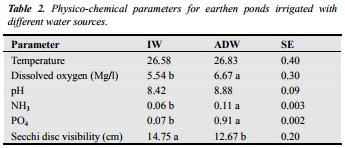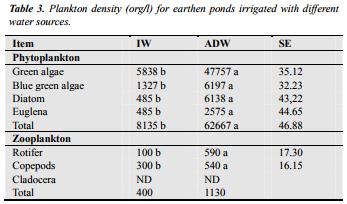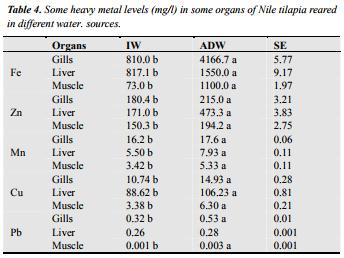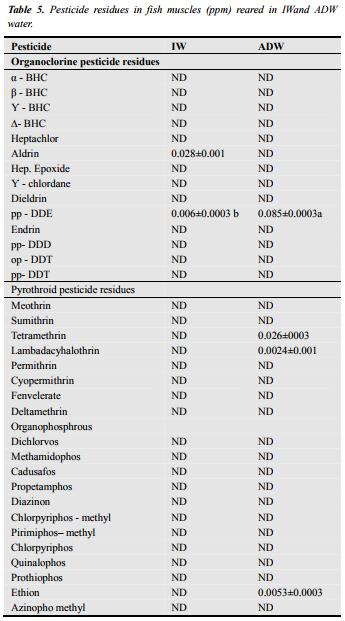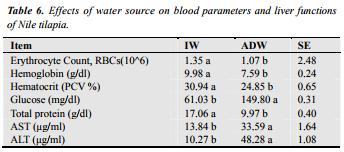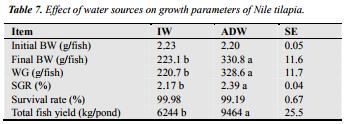1. Introduction
Aquaculture contributes about 74% of the total fish production in Egypt [1]. Egypt is an arid country that has a negative water balance. Its annual water supply from the Nile, rainfall along the Mediterranean coast and deep groundwater amount to approximately 57.7 billion cubic meters (BCM). But each year, the farms, industries, and people use around 72.4 BCM [2]. The reuse of drainage water is one of the main reasons why Egyptians can use a larger amount of water than that flows into the country. Egypt's limited freshwater resources are a major constraint to aquaculture development. Water usage is considered a national security issue, therefore, the use of water directly from the supply canals is allowed only for governmental hatcheries and not for fish farms which currently use water from the drainage canals [3]. Priority is given to potable water and crop irrigation, leaving more than 90 per cent of the country's fish farms to operate on agricultural drainage water. Agricultural drainage water containing pesticides and fertilizers and effluents of industrial activities and runoffs in addition to sewage effluents, supply the water bodies and sediment with huge quantities of inorganic anions and heavy metals [4]. Most of the heavy metals become bound to particles in sediment, but a small quantity becomes dissolved in the water and can spread widely in the food chains [5] especially these at the top of the food chain [6]. Metal ions can be incorporated into food chains and concentrated in aquatic organisms to a level that affect their physiological state. Several publications revealed the existence of pesticide residues in various aquatic ecosystems [7, 8 & 9]. El-Nemaki and Badawy [10 & 11] found that concentration of different heavy metals exceeded the maximum permissible concentrations in both Mugil cephalusand, Ctenopharyngodon idella tissues. Fish can store about 58-93% of pesticides in their tissues and water pollutants affect the fish reproduction. Barakat [12] found that organic contaminants or their metabolites affect spawning behavior and duration and also, the average number of eggs per spawning was higher in the control group than the contaminated ones.
The objective of the present study was to study the possibility of using ADW under Egyptian conditions to yield the best quantity and quality of fish for human consumption.
2. Material and Methods
Two fish farms of monoculture semi-intensive system were used in the present study located at Al-Abbassa, AbuHammad, Sharkia governorate, Egypt. The first farm includes 3 earthen ponds (2 hectare for each) that received their water from Ismailia canal (irrigation water). The second farm located at the same area and includes 3 earthen ponds (2 hectare for each) had water supply from agriculture drainage water. Before fish stocking, all ponds were completely drained and bottoms were exposed to sun radiation for two weeks thereafter filled with water and each pond was stocked with 40000 Nile tilapia O. niloticus (2.22±0.1g). Commercial feed (25% CP) was fed at rate of 3% of fish biomass. Formulation and proximate analysis of the experimental diet was illustrated in table (1).
2.1. Water Samples
Water samples were taken randomly from all ponds biweekly during the growth period (15 April to 15 November) with a column water sampler from at least six spots in each pond between 9.00 and 10.0 am at a depth of 30 Cm below the water surface. The samples were mixed together in a plastic container and analyzed for heavy metals residues, chemical, physical and biological parameters. Temperature and dissolved oxygen were measured by OxygenThermometer apparatus YSI model 58 (Yellow Spring Instrument Co. Yellow Springs, Ohio, USA). Transparency of water was measured directly by using Secchi disk. Hydrogen ion concentration (pH) was measured using a digital pH meter. Total ammonia was determined using a HACH water analysis while the concentration of total phosphorus, phytoplankton and zooplankton counts were determined according to methods of APHA [13].
2.2. Fish Samples
At harvest, sample of 10 fish were taken from each pond for measuring heavy metals and pesticides loads on fish organs. About 5 g from wet organs (liver, gills and muscles) was dried, ignited and digested with concentrated HNO3 and HCl according to procedures of AOAC [14]. The digested were analyzed for iron (Fe), zinc (Zn) manganese (Mn), copper (Cu), and lead (Pb) by atomic absorption spectrophotometer (Thermo electron corporations series AA Spectrometer). The soft parts of fish samples were removed and a muscle tissue sample (10 g from each treatments) was taken from the dorsal muscle in aluminum foil and kept in deep freezer until analysis [15]. The gas chromatography used to determination of organochlorine, pyrethroid and organophosphate pesticide residues, imidacloprid, methomyl, abamectin, and iufenuron were analyzed using high performance liquid chromatography (HPLC) Agilent 1100 series.
2.3. Blood Samples
Another 10 fish randomly chosen from each pond and blood samples were collected from the caudal vein. Blood samples were divided into two portions. The first one was collected with anticoagulant 10% ethylene-diaminetetraacetate (EDTA) to measure the erythrocyte counts (RBCs), hemoglobin (Hb) and hematocrit (Htc) according to the standard methods as described elsewhere by Rawling et al. [16]. The first portion (0.5 ml) was centrifuged at 1000 rpm for 5 min to separate the plasma to measure glucose and total protein. The second portion of the blood sample was allowed to clot overnight at 4°C and then was centrifuged at 3000 rpm for 10 min. The non-hemolysed serum was collected and stored at -20°C until use. Levels of serum aspartate aminotransferase (AST), alanine aminotransferase (ALT) were estimated according to the method described by Reitman and Frankel [17].
2.4. Growth Indices
Records of initial body weight (IBW) and final body weight (FBW) of each individual fish were measured in fish sample (200 fish/pond) at the initiation and the termination of the experiment. Weight gain (WG) and specific growth rate (SGR%), were calculated using the following equations: WG (g/fish) = FBW–IBW; SGR% = [lnFBW-ln IBW]/t×100, where FBW is final body weight (g); IBW is initial body weight (g); ln= natural logarithmic; t=time in days.
2.5. Statistical Analysis
Data were statistically analyzed by ANOVA using SAS ANOVA procedure [18]. The data were submitted to one way classification variance analysis. Duncan’s multiple range test was used to compare differences between treatment means when significant F values were observed [19] at P<0.05 level.
3. Results
3.1. Physico-Chemical Analysis of Water
Ponds supplied with irrigation water showed slightly lower average temperature (26.58°C) and pH (8.42) in comparison to ponds that received agriculture drainage water (26.83°C and 8.88, respectively) and the differences among the two water sources were insignificant (table 2). On the other hand, ADW ponds showed the significant (P<0.05) higher dissolved oxygen (6.67 mg/l), total ammonia (0.11 mg/l) and available phosphorus (0.91 mg/l) instead of 5.54 mg/l, 0.06 mg/l and 0.07 mg/l for dissolved oxygen, total ammonia and available phosphorus, that measured in IW, respectively. ADW showed the lowest significant (p<0.5) Secchi disc reading (12.67 cm) while IW showed the highest reading (14.75 cm).
3.2. Plankton Density
Results in table 3 showed that ADW had the highest significant density of phytoplankton (62667 organism/l) in comparison to irrigation water (8135organism/l). The phytoplankton population was significantly dominated by green algae, blue green algae, diatom and euglena in ADW. Also, ADW had the highest significant count of zooplankton (1130 org/l) comparable to IW (400 org/l). Zooplankton population was significantly dominated by Rotifer and Copepods while Cladocera absent in each of IW and ADW (table 3).
3.3. Heavy Metals in Fish Organs
The highest levels of Fe in gills (4166.7 ppm), liver (1550.0 ppm) and muscles (1100.0 ppm) were detected in fish reared in ADW followed by IW (810.0, 817.1 and 73.0 ppm, respectively) and the differences in Fe concentration of gills, liver and muscles among the two water sources were significant (P<0.05). Similar trend was also observed with respect to the accumulation of Zn, Mn, Cu and Pb except for Pb in liver where there is no significant differences among fish reared in ponds irrigated with the two water sources (table 4). In this study, Fe had the highest concentration values of metals content of fish organs (liver, gills and muscles) of fish reared in the two water types. Also, the accumulation trends of heavy metals in O. niloticus muscles found in the order of Fe > Zn >Mn> Cu >Pb.
3.4. Pesticide Residues in Fish Muscles
Table 5 outlined the accumulation of some pesticide residues in tilapia muscles. Results showed wide variations in accumulation of pesticides among ponds received ADW and those received IW. All organoclorine pesticide residue were absent in fish muscles except of Aldrin which presented (0.028 ppm) in IW only. On the other hand, ppDDE residues were presented in significant level (0.085 ppm) in fish muscles of ADW instead of fish reared in IW (0.006 ppm). Similar results were also obtained for Pyrothroidpesticide residues whereas tetramethrin and lambadacyhalothrin were presented only in fish muscles of ADW at a levels of 0.026 and 0.0024 ppm, respectively. Ethion is the only organo phosphorus pesticide residues detected in fish muscles of ADW (0.0053 ppm).
3.5. Hematological and Biochemical Blood Indices
Fish reared in ADW showed the lowest significant (P<0.05) count of red blood cells (1.07), haemoglobin (7.59g/dl), hematocrit and (24.85) total protein (9.97g/dl) while fish raised in IW showed the highest red blood cells (1.35), Haemoglobin (9.98g/dl), hematocrit and (30.94%)) total protein (17.06g/dl). Fish reared in ADW showed the highest levels of glucose (149.8 mg/dl) and amino transferases, AST (33.59µg/ml) and ALT (48.28µg/ml) compared to 61.03 mg/dl, 13.84µg/ml and 10.27 µg/ml for glucose, AST and ALT that recorded for fish reared in IW, respectively (table 6).
3.6. Growth Performance
Initial fish weight averaged 2.23 and 2.20 g for fish stocked in ponds irrigated with IW and ADW, respectively and differences among these means were insignificant (table 7). At experiment end (after seven months), final body weights were 223.10, and 330.8 for fish groups reared in IW and ADW, respectively (table, 7). ADW ponds produced the highest significant weight gain (328.6 g/fish) in comparison to IW (220.7 g/fish). In the same trend, fish reared in ADW showed the highest significant SGR (2.39%) instead of 12.7% for fish raised in IW.
4. Discussion
4.1. Physico-Chemical Analysis of Water
Physico-chemical parameters of water play a significant role in fish biology and physiology [20]. Water temperature is one of the most influencing environmental factors affecting pond dynamics and both the metabolism and fish growth [21]. In the present study, water temperature ranged between 26.58 to 26.83°C (table 2) therefore, water temperature was favorable for fish culture in each of IW or ADW and this average indicates a good potential of fish production because the optimum temperature range for many warm water species is 24 to 30°C [21].
Desirable concentration of dissolved oxygen for most fish is 5 mg/l and above, therefore, dissolved oxygen level measured in the present study for IW (5.54 mg/l) and ADW (6.67 mg/l) were favorable for fish culture [21]. The highest DO level in ADW in our study may be due to the abundance of phytoplankton that increases photosynthetic activity leading to production of large amount of DO and comply with results of EL-Nemaki et al. [6].
pH values for ADW were higher (but not significant) than that recorded in IW and this attributed to the higher nitrogen and phosphorus concentrations in ADW which contain more phytoplankton than IW. Padmavathi and Prasad [22] indicated that high pH levels in pond water are associated with algal blooms. The obtained results also showed that the total ammonia (NH3) was higher in ADW than IW and this may be due to decomposition or organic matter in ADW. Ammonia formation depends on water pH and temperature, where at high pH and water temperature, free toxic ammonia is released to critical levels [23 & 24].
Available phosphorus concentration (mg/l) was significantly higher in ADW compared to IW. The drastic increase in total phosphorus concentration in pond water was attributed to the high phytoplankton abundance and aquatic organisms in ADW comparable to those of IW [25].
Secchi disc visibility measure water turbidity which is usually caused by suspended soil particles and/or plankton abundance, therefore, water transparency showed an increase correlation to plankton abundance [21]. The present results showed lower visibility in ADW instead of IW and this may be due to the higher accumulation of phytoplankton in the ADW while high transparency at IW was due to their low phytoplankton. This agrees with the finding of Soltan et al. [26 & 27] and confirmed to results of El-Nemaki et al. [6] who showed lower visibility in ADW compared to IW. The values of most physico-chemical parameters of irrigation and agricultural drainage water sources appeared to be within the acceptable ranges for the Fish Farm Standards according to Meade [28].
4.2. Plankton Abundance
Green algae, blue green algae, diatoms and euglena in ADW recorded the highest significant (P<0.05) count due to increase of ammonia concentration as a result of fish farming activities (table 3). Ammonia could be absorbed by the available phytoplankton which subsequently converts the nitrogenous compounds into amino acids which depict a much idealized algal cells as pointed out by Vymazal [29]. As mentioned above Secchi disc reading was higher in the ADW and this support the latter finding and this complies with most of the previous studies [6 & 30] who stated that the increased levels of the phytoplankton standing crop could be related to the lower value of Secchi disc. Agricultural drainage water also showed the highest count of rotifer and copepods than due to the high fertility of ponds that received ADW rich in organic matter and other nutrients and also due to the high phytoplankton abundance in ADW.
4.3. Heavy Metals in Fish Organs
Heavy metals (Fe, Zn, Mn, Cd and Pb) in fish gills, liver and muscle that collected from ponds received ADW are very variable and significantly (P<0.05) higher than that determined in fish organs of IW (table 4). The obtained results might be related to the higher density of phytoplankton in the ADW and this can be due to the feeding habits of farmed fish which feed on pollution free artificial diets in high amounts (in IW) compared to feeding on polluted natural food, primarily algae in ADW. Kucuksezgin et al. [31] stated that phytoplankton occurred in the ecosystem could absorb and accumulated heavy metals. Accumulation of heavy metals in different fish organs depends on their physiological role, behavior, and feeding habits, as well as regulatory ability. Therefore, the accumulation of heavy metals in liver may be because liver being the responsible organ in controlling the toxicity of heavy metals. Also, gills can uptake heavy metals at higher levels due to their distinct role in metal exposure [32]. Jobling [33] attributed the high accumulation of heavy metals in liver and gills tissues to the metallothioneins proteins which are synthesized in liver and gills tissues when fishes are exposed to heavy metals and detoxify them. These proteins are thought to play an important role in protecting them from damage by heavy metals toxicants. Also, gills are the site directly exposed to the ambient conditions and also are known for their excretory function even for some metals like zinc [34].
WHO [35] indicated that the acceptable limits in fish tissues were 30 µg/g for Fe; 20 µg/g for Cu; 50 µg/g for Zn and 0.2 µg/g for Pb. So, it is worth to mention that, the concentration of heavy metals in muscles of fish reared in IW or ADW lies within the safe limits, while their concentrations in gills and liver tissues exceeded these limits. Therefore, fish consumer must get ride off the internal viscera and head before processing any type of fish, due to the fact that these organs contain the highest pollutants.
4.4. Pesticide Residues in Fish Muscles
Organochlorine pesticides tend to accumulate in living organisms especially in aquatic organisms and they substantially settle on the sediments [36]. Exposure to aldrin and dieldrin happens mostly from eating contaminated foods, such as root crops, fish, or seafood as these build up in the body after years of exposure and may affect the nervous system. Our result indicated that Aldrin level found to be 0.028 ppm in muscles of fish reared in IW and absent in ADW (table 5) and this means that aldrine degraded by bacteria which leave in ADW. Razia et al. [37] showed that sunlight and bacteria change aldrinin to dieldrin. It is because that we mostly find dieldrin in the environment as it they bind tightly to the soil and breaks down very slowly and evaporate into the air. The Food and Drug Administration of USA [38] regulates the residues of aldrin and dieldrin in raw foods and their permissible range is between 0 to 0.1 ppm, depending on the type of food product.
Akan et al. [36] found that the main group of pesticides found in fish samples collected from culture ponds, cages and sea are the pesticides related to DDT and its metabolites TDE, DDE, and DDMU. Results of table (5) showed that pp-DDE found to be 0.006 and 0.085 ppm in IW and ADW, respectively. The hazards for the consumption of sea fish or shrimp by human beings with such levels of DDT are negligible, since the oral toxicity of DDT has been found to basis at the level of 200 mg/kg body weight. The limit per kg body weight, calculated on this would require a consumption of 100 kg fish containing 2 ppm of total DDT. For a man of 50 kg body weight it means that the limit of consumption (in a short period) is 5000 kg of fish. Henceforth even with a safety factor of 10, there is no danger in consuming fish [39]. During the present study pesticides mainly belonging to the DDT group have been found their concentration was under the permissible limit. This observation has been substantiated further by the absence of changes in behavior, weight loss, inability to avoid predators, and lowered tolerance to extreme temperatures, which are reported in the cases of the intake of sub lethal doses of such pesticides [40].
Tetramethrin and lambadacyhalothrin are the only pyrothroid pesticide residues presented in ADW (0.026 and 0.0024 ppm, respectively) and were not detected in IW. This could be explained by the higher density of phytoplankton in drainage water which could absorb a high quantity of most pesticides [10 & 11].
The organophosphorus pesticides (Ops) are much more resistant to microbial degradation and have a propensity to concentrate in rich lipid tissues of aquatic organisms and most mammals. These properties lead directly to their most undesirable characteristics; the environmental persistence, bio-concentration, and bio-magnifications through the food chain. Diazinon and Ethion which are readily deactivated and degraded by micro-organisms and therefore do accumulate [41]. In the present study, diazinon not detected in fish muscles for IW or ADW while Ethion was detected at a level less that the limits of WHO [42] (the maximum residue limits (MRLs) is 0.3 mg/kg for Ethion). As described by Gerken [41], the maximum residue limits (MRL) is the maximum amount of the pesticide residue which is found in food substances that will not cause any health effect or hazard. Consequently, the public is not at risk from fish consumption.
4.5. Hematological and Biochemical Blood Indices
Physiological changes in farmed fish might be indicative of unsuitable environmental conditions or presence of stressors [43]. As we mentioned above, fish reared in ADW showed the lowest significant count of red blood cells (RBCs) than fish reared in IW (table 6) and these results came in parallel with those recorded for hemoglobin (Hb), hematocrit Htc, total protein while the opposite trend was observed for glucose and liver enzymes (AST and ALT). RBCs are important when investigating anemia and blood-forming function because they are responsible for the transport and excretion of nutrients, oxygen, body wastes, and carbonic acid gas [44]. Based on the lower Htc and Hb levels might induce anemia or hemolysis in Nile tilapia owing to the decreased synthesis of erythrocytes in the bone marrow equivalents [45].
Results of table 6 showed a significant difference in glucose level among IW (61.03) and ADW (149.80) and this could be explained by stress on fish reared on ADW which contained some pollutants and the highest ammonia level in ADW (Table 2). Ammonia an effect is known to increase plasma glucose levels and this confirm the corticosteroid response to high ammonia observed by Davis et al. [46] who indicated that blood glucose increased due to stimulation of glucocorticoids in stressed catfish and Metwally and Wafeek [47] in stressed Nile tilapia. Stress may thus lead to a high consumption of energy reserves, and this reallocation of metabolic energy negatively interferes with other physiological processes, namely growth, reproduction, immunity, and so on [48]. Total protein level found to be 17.06 and 9.97 g/dl for fish reared in IW and ADW, respectively. Total protein in fish decreased significantly under stress conditions and/or at high density; this depletion may have been due to the utilization of these molecules for metabolic purposes [49].
Likewise, AST and ALT of Nile tilapia reared in ADW increased significantly, demonstrating liver function impairment when fish were cultured at stress. Gan et al. [50] came to similar results in grass carp. The rise in hepatic activity of protein-metabolizing enzymes in stressed fish may indicate use of dietary amino acids for growth as well as substrate for gluconeogenesis, particularly for AST and ALT. Abdel-Tawwab [51] found an increases in AST and ALT activities of Nile tilapia due to high density. Banaee et al. [52] reported increased levels of these transferases, AST and ALT followed by the exposure of Cyprinus carpio to diazinon.
4.6. Growth Performance
Nile tilapia reared in ponds irrigated with agricultural drainage water resulted the highest significant (P<0.05) final body weight (330.8 g/fish) comparable to fish reared in IW (223.1 g/fish) and the same trend was also observed for weight gain (WG) and specific growth rate (table 7). The highest values of BW, WG and SGR values that recorded for fish reared in ADW may be related to the higher water productivity and good nutritive condition which consequently increased fish growth as reported by Soltan et al. [26]. Fish yield of Nile tilapia in agricultural drainage water was positively correlated to net primary productivity which was linearly correlated with the availability of natural food in ponds [53]. Survival rate for fish reared in ADW (99.19%) were slightly (but not significant) lower than that recorded for IW (99.98%) indicating that survival and growth performance of Nile tilapia were not limited by any of the water quality parameters.
5. Conclusion
From previous discussion, we can conclude that fish quality produced in the agriculture drainage water meets the standard fish quality levels because this water is not highly contaminated with heavy metals or pesticides. Furthermore, the agriculture drainage water was highly productive and this might have minimized the pollutants contents of water and have a positive effect on fish growth and quality. So, this water may be used as feeding source to rearing of the fish farms at Al-Abbassa area under the condition of carrying out complete analysis of the water and fish before and on a periodical basis during the fish growing seasons to assure good quality of water and fish production.
This article was originally published in Ecology and Evolutionary Biology 2016; 1(3): 68-75 http://www.sciencepublishinggroup.com/j/eeb. doi: 10.11648/j.eeb.20160103.15. This is an Open Access article distributed under Creative Commons Attribution (CC BY) license (http://creativecommons.org/licenses/by/4.0/). References
[1] GAFARD (2013). General Authority for Fish Resources. Fish Production Statistics, 2012. Ministry of Agriculture, Cairo, Egypt.
[2] Barnes, J. (2014): Mixing waters: The reuse of agricultural drainage water in Egypt. Geoforum, 57:181-191.
[3] Soltan, M. (2013): Intensification of fish production in Egypt. Technical report submitted to the general committee for the promotion of Professors (Animal production), Cairo, Egypt.
[4] ECDG, (2002): European Commission DG ENV. E3 Project ENV. E.3/ETU/0058. Heavy metals in waste. Final report.
[5] Khadr, A. M. (2005): Copper concentrations and phases in polluted surface sediments of Lake Edku, Egypt. Egyptian Journal of Aquatic Research, 31(2): 253–260.
[6] El-Nemeki, F. A; Nema, A. Ali; Zeinhom, M. M. and Olfat A. Radwan (2008) Impacts of different water resources on the ecological parameters and the quality of tilapia production at El-Abbassa fish farms in Egypt 8th international symposium on tilapia in aquaculture, 491-512.
[7] Gupta, G, Z. H. Zidan, M. I. Bdel-Mageed, K. A. Mohamed and A. E. Bayoumi. 2002. Monitoring of the pesticide residues and metals in water soil systems in industrial and agricultural areas at Kalubia governorate, Egypt. The first Conf. of the Central Agric, Pesticide Lab. 3-5 Sept: 19-138.
[8] Radwan, O. A. and I. E. Atalla. 2005. Monitoring of pesticide residues in agriculture drainage water and fish samples collected from different governorates, Egypt. Bull. Fac Agric. Cairo Univ. 56: 189-200.
[9] Radwan, O. A. 2008. Monitoring of some pesticide residues in water and fish tissue samples collected from three locations at Sharkia governorate, Egypt. J. Biol- Chem. Environ. Sci. 3. 1:583-597.
[10] El-Nemeki, F. A and T. E. Badawy. 2005. Effect of water quality and seasonal variations on heavy metals concentrations in Mugil cephalus tissues, at El-Abbassa fish farm Egypt. Ain Shams Science. Bulletin.43: 33-44.
[11] El-Nemeki, F. A and T. E. Badawy. 2006. Impact of different water resources and seasonal variations on the heavy metals concentration in grass carp, Ctenopharyngodon idella. African. J. Biol Sci. 2. 2:67-74.
[12] Barakat, K. K. 2004. Effect of some water pollutants on the biology of the Nile Bolti, Oreochromis niloticus. Pakistan. J. Biologcal Scinces, 7:305-308.
[13] APHA 1985. Standard methods for examination of water and waste water. Amrican Puplic Health Association. Washington. D. D. USA.
[14] AOAC 1990. Association of Official Analytical Chemists. Official Methods of Analysis. 13th Ed. Washington DC, USA.
[15] UNEP (United Nations Environmental Program) (2007). "Guidance for Analysis of persistent Organic Pollutants (POPs)." Field Sampling Procedures, UNEP Chemicals Branch, DTIE, Guidance on the Global Monitoring Plan for Persisent Organic Pollutants, May 2007.
[16] Rawling, M. D. Merrifield, D. L. Davies, S. J. 2009. Preliminary assessment of dietary supplementation of Sangrovit® on red tilapia (Oreochromis niloticus) growth performance and health. Aquaculture 294, 118-122.
[17] Reitman, S. Frankel, S. 1957. A colorimetric method for the determination of serum glutamic oxalacetic and glutamic pyruvic transaminases. Am. J. Clin. Pathol. 28, 56-63.
[18] SAS (2004). SAS Procedure Guide version 6.12 Ed. SAS Institute Inc. Cary, NC, USA.
[19] Duncan, D. B. (1955). Multiple range and multiple F tests. Biometrics. 11: 1-42.
[20] Dhawan, A, and Kaur, S. (2002). Pig Dung as pond manure: Effect on water quality, pond productivity and growth of carps in polyculture system. Naga, the ICLARM Quarterly, 25(1): January-March 2002.
[21] Boyd, C. E. 1990. Water Quality in ponds for aquaculture. Agriculture Experiment Station, Auburn Univ. Alabama, U.S.A: 482.
[22] Padmavathi, P. and Prasad, M. K. D. (2007). Studies on algal bloom disasters in carp culture ponds. Braz. J. Morphol. Sci, 24(2): 32-43. Pesticide manual (2005): Version 3-1, thirteenth edition.
[23] Abdel-Hakim, N. F.; Bakeer, M. N. and Soltan, M. A. (2000): Effect of two manuring systems on water quality and plankton communities in fish ponds. Conference of Social and Agricultural Development of Sinai, El-Arish-North Sinai, 16-19 May, Egypt, 147-158.
[24] Abdel-Hakeem, N. F. Bakeer, M. N. and Soltan, M. A. (2002). Aquatic Environment for Fish Culture. Deposit No. 4774/2002. Cairo, Egypt.
[25] Ahmed, Z. A.1983. Studies on phytoplankton of the Nile system in Upper Egypt. M.Sc. Thesis. Assiut Univ. Egypt.
[26] Soltan, M. A. Bakeer, M. N. and Samra, I. M. (2006): Effect of some feeding regimes on water quality, growth and productivity of Nile tilapia, Oreochromis niloticus reared in earthen ponds. Egypt. J. Agric. Res. 84(1A):1-18.
[27] Soltan, M. A. Mahmoud, A. S. Aida M. Dawah and Soha M. Ahmed (2014): Selective feeding of Nile tilapia and silver carp on green algae and cyanobacteria in aquaculture. Abbassa Int. J. Aqua. 7(1):120-143.
[28] Meade, J. W. (1989): Aquaculture management. New York: Van NostrandReinhold.
[29] Vymazan, J. 1995. Algae and element cycling in wet lands. Duke Univ. School of the environment. Duke wet land center Durham, North Calorina. CRC Press. Inc.
[30] Kattaby, A. A. Fayza E. Abbas, Soltan, M. A. and ElSayaad, G. A. (2010): Effect of using different water sources on the growth performance of mono sexed Nile tilapia (Oreochromis niloticus) reared in earthen ponds. Abbassa Int. J. Aqua. Special Issue (The Third Scientific Conference Al Azhar University, Cairo 17-18 October 2010. pages 129-142.
[31] Kucuksezgin, F. Kontas, A. Altay, O. Uluturhan, E. and Darilmaz, E. 2006. Assessment of marine pollution in Izmir bay: nutrient, heavy metal and total hydrocarbon concentrations. Environ. Int. 32: 41-51.
[32] Kraemer, L. D. Campbell, P. G. & Hare, L. (2005). Dynamics of Cd, Cu and Zn accumulation in organs and sub-cellular fractions in field transplanted juvenile yellow perch (Perca flavescens). Environmental Pollution, 138(2), 324-337.
[33] Jobling, M. (1995): Environmental Biology of Fishes. First edition. Printed in Great Britain. Chapman and Hall, London.
[34] Matthiessen, P. and Brafield, A. E. (1977). Uptake and loss of dissolved zinc by the stickleback Gasterosteus aculeatus L. Journal of Fish Biology, 10(4), 399-410.
[35] WHO, World Health Organization. 1984. Guide lines for drinking water quality. Vol. 1, Recommendations. Geneva. 63.
[36] Akan J. C. Abdulrahman, F. I. and Chellube, Z. M. (2014): Organochlorine and organophosphorus pesticide residues in fish Samples from Lake Chad, Baga, North Eastern Nigeria, International Journal of Innovation, Management and Technology, 5(2):87-92.
[37] Razia S. Ali, W. Ameer, F. Munshi, A. B. and Nasir, M. (2012): Accumulation of pesticide residues by shrimp, fish and brine shrimp during pond culture at Ghorabari (District Thatta), J. Chem. Soc. Pak. Vol. 34(3): 541-549.
[38] FDA (2001): The Food and drug Administration of USA. FDA, Veterinarian.16, 5 (2001).
[39] Epifanio, C. E. (1972): Effects of dieldrin-contaminated food on the development of Leptodius floridanus larvae. Marine biology, 13(4):292-297.
[40] Helfrich, L. A. Weigmann, D. L. Hipkins, P. and Stinson, E. R. (1996): Pesticides and aquatic animals: A Guide to reducing impacts on aquatic system. Virginia Cooperative Extension, Publication 420-013.
[41] Gerken, A. J. Suglo, V. and Braun, M. (2001): Crop protection policy in Ghana for Ministry of food and agriculture, Intergrated crop protection project PPRST/GTZ, Pokuase/Accra 162.
[42] WHO, World Health Organization (2005) Recommended Classification of Pesticides by Hazard and Guideline to Classification. WHO, Geneva, Switzerland. World Health Organization. Public Health Impact of Pesticides used in Agriculture. WHO, Geneva, Switzerland 51:86.
[43] Abdel-Tawwab, M. Hagras, A. E. Elbaghdady, H. M. and Monier, M. N. (2014). Dissolved oxygen level and stocking density effects on growth, feed utilization, physiology, and innate immunity of Nile tilapia, Oreochromis niloticus Journal of Applied Aquaculture, 26(4):340-355.
[44] Kim, C. Y.; Lee, H. S.; Han, S. C.; Heo, J. D; Ha, C. S.; Kwon, M. S. and Chung, M. K. (2004). Haematological and plasma biochemical variables in cynomolgus monkeys, Korean J. Lab. Anim. Sci. 20: 44-48.
[45] Morgan, D. P.; Stockdale, E. M. Roberts, R. J. and Walter, H. W. (1980). Anemia associated with exposure to lindane, Arch. Environ. Health, 35:307-310.
[46] Davis, K. B. B. R. Griffin and W. L. Gray, 2003. Effect of dietary cortisol on resistance of channel catfish to infection by Ichthyophthirius multifiliis and channel catfish virus disease. Aquaculture, 218: 121-131.
[47] Metwally. M. A. A. and Wafeek, M. (2014). Effect of ammonia toxicity on carbohydrate metabolism in Nile Tilapia (Oreochromis niloticus). World Journal of Fish and Marine Sciences 6 (3):252-261.
[48] Mommsen, T. P. Vijayan, M. M. and Moon, T. W. (1999): Cortisol in teleosts: Dynamics, mechanisms of action, and metabolic regulation. Reviews in Fish Biology and Fisheries 9:211-268.
[49] Adamu, K. M. and Kori-Siakpere, O. 2011. Effects of sublethal concentrations of tobacco (Nicotiana tabaccum) leaf dust on some biochemical parameters of Hybrid catfish (Clarias gariepinus and Heterobranchus bidorsalis). Brazilian Archives of Biology and Technology, 54(1):183-196.
[50] Gan, L. Liu, Y. J. Tian, L. X. Yue, Y. R. Yang, H. J. Liu, F. J. Chen, Y. J. and Liang, G. Y. (2013). Effect of dissolved oxygen and dietary lysine levels on growth performance, feed conversion ratio and body composition of grass carp, Ctenopharyngodon idella. Aquaculture Nutrition 19(6):860- 869.
[51] Abdel-Tawwab, M. (2012): Effects of dietary protein levels and rearing density on growth performance and stress response of Nile tilapia, Oreochromis niloticus (L.). International Aquatic Research 4(3): 1–13.
[52] Banaee, M. Mirvagefei, A. R. Rafei, G. R. and Amiri B. M. ((2008). Effect of sub-lethal diazinon concentrations on blood plasma biochemistry. Inter. J. Envir. Res. 2, 189-198.
[53] Yi, Y. (1998). A bioenergetics growth model for Nile tilapia (Oreochromis niloticus) based on limiting nutrients and fish standing crop in fertilized ponds. Aquacultural Engineering, 18:157-173.
[54] NRC (1993). National Research Council. Nutrient Requirements of Fish. National Academy Press, Washington, DC, 114 pp.

